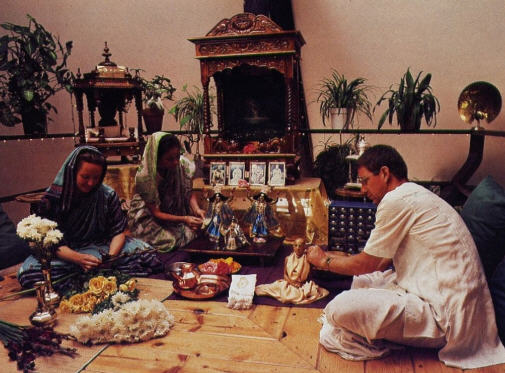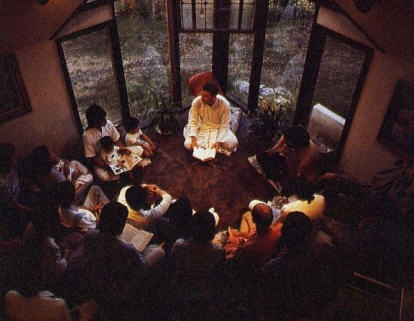
Finding fertile ground for spiritual life in the California hills.
Treasure hunt clue: "Follow this path. Don't be led astray, and you will find: a ruler stays straight on the righteous path and always calculates what's best for human society. One who bows at the feet of such a ruler may find a useful treasure.…"
May 10 was Jivananda dasa's tenth birthday, and he and five of his friends were celebrating with a treasure hunt around his home in Topanga Canyon, California. It was a warm, sunny Saturday morning, and I watched the children as they ran through tall grasses and brightly colored wildflowers. With the Santa Monica mountain range forming a giant backdrop behind the children, I had to remind myself that the scene was just twenty-five minutes from downtown Los Angeles and not in some wilderness.
Jivananda's father, Nrsimhananda dasa, had first noticed the Topanga plot of land in 1976 and, with his mother's help, had purchased it. Srila Prabhupada, the founder and spiritual master of the Hare Krsna movement, had said that there should be ten centers for bhakti-yoga in the Los Angeles area. By 1976 the large New Dvaraka complex on Watseka Avenue in Los Angeles was well established, so the time seemed right to begin another center.
Nrsimhananda chose the pyramid shape for the Topanga center, and in 1978, long before all the finished work had been done on the first of their three pyramids, Nrsimhananda, his wife, Mohana, and their son, Jivananda, moved in. For their house-warming ceremony they posted large signs along the six-mile route from the Pacific Coast Highway to the Pyramid Center and spent several days at nearby Santa Monica Beach performing kirtana (singing the Hare Krsna mantra and dancing) and distributing invitations. The following Sunday they received fifty guests. And about that many have been coming every Sunday since.

Nrsimhananda divides his days between maintaining and expanding the Pyramid Center and managing and directing ITV (ISKCON Television), the video arm of the Hare Krsna movement. In the morning, after the regular temple services, he may be found tending fruit trees in the gardens, cleaning the temple floors, or supervising construction of additional living quarters for the devotees. Later he's usually editing scripts or shooting video productions in the Culver City ITV office, just a block from ISKCON's New Dvaraka community. Nrsimhananda's wife, Mohana, is as energetic and enthusiastic as he is. She hosts numerous visitors to the Pyramid Center and also serves as principal of the New Dvaraka Elementary School. She recently gave birth to another son.
Since Nrsimhananda and Mohana began the center eight years ago, a number of devotees and aspiring devotees have lived with them. At present three husband-and-wife teams and three single men stay there. They are a harmonious crew, dedicated to assimilating and presenting Krsna consciousness as it is, and dedicated to following Srila Prabhupada's teachings by making their home into a temple.
As Nrsimhananda explained, "By keeping an open house for Krsna I've realized that I've also begun to keep an open heart for Krsna." Last year Mohana's brother visited the Pyramid Center and, inspired by its success and potential, helped purchase an adjacent acre for the center's gardens and for future development. Now a narrow path winds through the two-acre property, and one who walks that path for the first time is repeatedly startled by magnificent sculptures of the incarnations of Krsna that all but emerge from the bushes along the way Buddha, Kalki, Nrsimhadeva, Krsna and Balarama, and Sita-Rama. The sculptures were cast on site and finished by the devotees.
It was under and around these sculptures that Jivananda and his friends found their treasures while playing their Krsna conscious game a search around the feet of the divine King Rama rewarded one boy with a ruler that had a calculator built into it.
The devotees at the Pyramid Center surrender their activities, assets, and thoughts to Krsna. As a result their lives are becoming anxiety-free and sublime. This process and its result is expressed in a Bengali song by a great nineteenth-century pioneer of the Krsna consciousness movement:
manasa deho geho jo kichu mor
arpilu tuwa pade nanda-kisor
sampade vipade jivane-marane
day mama gela tuwa o-pada barane
"Mind, body, and family, whatever may be mine, I have surrendered at Your lotus feet, O youthful son of Nanda [Krsna]! In good fortune or in bad, in life or at death, all my difficulties have disappeared by choosing those feet of Yours as my only shelter."
